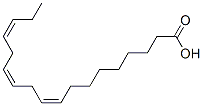Description
α-Linolenic acid (ALA) is an organic compound found in many common vegetable oils. In terms of its structure, it is named all-cis- 9,12,15-octadecatrienoic acid. In physiological literature, it is given the name 18:3 (n?3).
α-Linolenic acid is a carboxylic acid with an 18-carbon chain and three cis double bonds. The first double bond is located at the third carbon from the methyl end of the fatty acid chain, known as the n end. Thus, α-linolenic acid is a polyunsaturated n?3 (omega-3) fatty acid. It is an isomer of gamma-linolenic acid, a polyunsaturated n?6 (omega-6) fatty acid.
Occurrence
Seed oils are the richest sources of α-linolenic acid, notably those of chia, perilla, flaxseed (linseed oil), rapeseed (canola), and soybeans. Alpha-Linolenic acid is also obtained from the thylakoid membranes in the leaves of Pisum sativum (pea leaves). ALA is not suitable for baking, as it will polymerize with itself, a feature exploited in paint with transition metal catalysts. Some ALA will also oxidize at baking temperatures.
History
Alpha-linolenic acid was first isolated by Rollett as cited in J. W. McCutcheon's synthesis in 1942 , and referred to in Green and Hilditch's 1930's survey. It was first artificially synthesized in 1995 from C6 homologating agents. A Wittig reaction of the phosphonium salt of [(Z-Z)-nona-3,6-dien-1-yl]triphenylphosphonium bromide with methyl 9-oxononanoate, followed by saponification, completed the synthesis.
Definition
ChEBI: Alpha-linolenic acid is a linolenic acid with cis-double bonds at positions 9, 12 and 15. Shown to have an antithrombotic effect. It has a role as a micronutrient, a nutraceutical and a mouse metabolite. It is an omega-3 fatty acid and a linolenic acid. It is a conjugate acid of an alpha-linolenate and a (9Z,12Z,15Z)-octadeca-9,12,15-trienoate.


